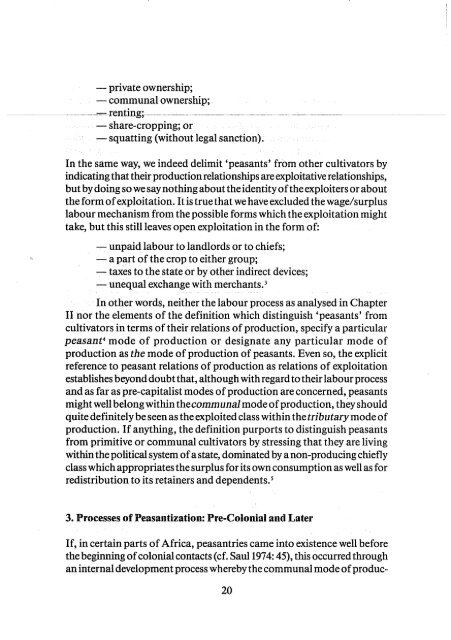Create successful ePaper yourself
Turn your PDF publications into a flip-book with our unique Google optimized e-Paper software.
- private ownership;<br />
communal ownership;<br />
-----renting;<br />
- share-cropping; or<br />
- squatting (without legal sanction).<br />
In the same way, we indeed delimit 'peasants' from other cultivators by<br />
indicating that their production relationships are exploitative relationships,<br />
but by doing so we say nothing about the identity ofthe exploiters or about<br />
the form of exploitation. It is true that we have excluded the wage/surplus<br />
labour mechanism from the possible forms which the exploitation might<br />
take, but this still leaves open exploitation in the form of:<br />
- unpaid labour to landlords or to chiefs;<br />
- a part of the crop to either group;<br />
- taxes to the state or by other indirect devices;<br />
- unequal exchange with merchants. 3<br />
In other words, neither the labour process as analysed in Chapter<br />
II nor the elements of the definition which distinguish 'peasants' from<br />
cultivators in terms of their relations of production, specify a particular<br />
peasant 4 mode of production or designate any particular mode of<br />
production as the mode of production of peasants. Even so, the explicit<br />
reference to peasant relations of production as relations of exploitation<br />
establishes beyond doubt that, although with regard to their labour process<br />
and as far as pre-capitalist modes of production are concerned, peasants<br />
might well belong within thecommunal mode of production, they should<br />
quite definitely be seen as the exploited class within the tributary mode of<br />
production. If anything, the definition purports to distinguish peasants<br />
from primitive or communal cultivators by stressing that they are living<br />
within the political system of a state, dominated by a non-producing chiefly<br />
class which appropriates the surplus for its own consumption as well as for<br />
redistribution to its retainers and dependents. 5<br />
3. Processes of Peasantization: Pre-Colonial and Later<br />
If, in certain parts of Africa, peasantries came into existence well before<br />
the beginning of colonial contacts (cf. Saul 197 4: 45), this occurred through<br />
an internal development process whereby the communal mode of produc-<br />
20
















